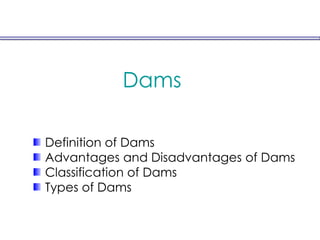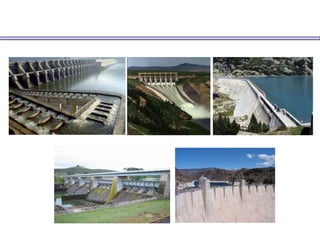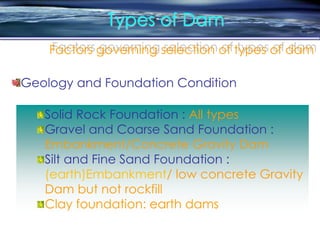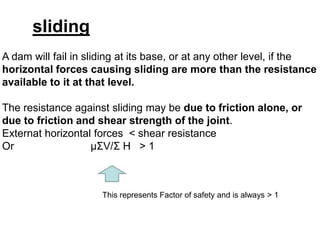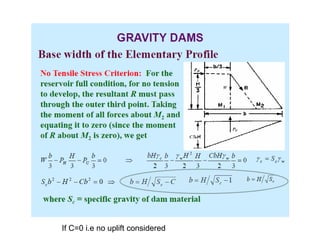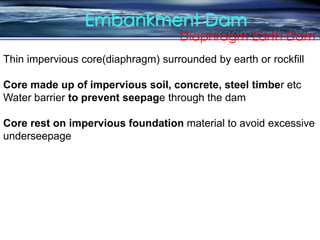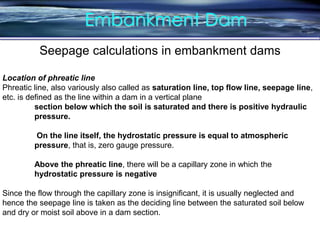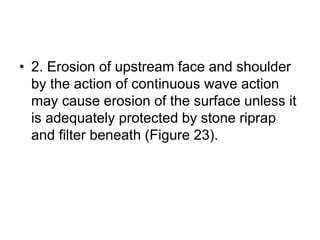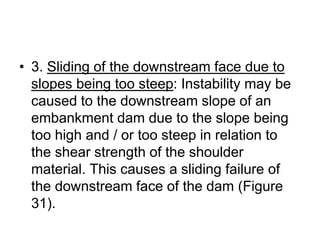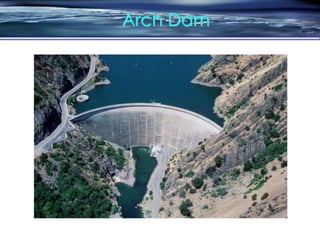Dams 1
- 1. Dams Definition of Dams Advantages and Disadvantages of Dams Classification of Dams Types of Dams
- 3. What is a Dam? A dam is a structure built across a stream, river or estuary to retain water. Dams are made from a variety of materials such as rock, steel and wood.
- 4. Dams
- 5. Dams
- 7. Definitions Heel: contact with the ground on the upstream side Toe: contact on the downstream side Abutment: Sides of the valley on which the structure of the dam rest Galleries: small rooms like structure left within the dam for checking operations. Diversion tunnel: Tunnels are constructed for diverting water before the construction of dam. This helps in keeping the river bed dry. Spillways: It is the arrangement near the top to release the excess water of the reservoir to downstream side Sluice way: An opening in the dam near the ground level, which is used to clear the silt accumulation in the reservoir side.
- 8. Advantages of Dam Irrigation Water Supply Flood Control Hydroelectric Recreation Dams gather drinking water for people. Dams help farmers bring water to their farms. Dams help create power and electricity from water. Dams keep areas from flooding. Dams create lakes for people to swim in and sail on.
- 9. Disadvantages of Dam Dams detract from natural settings, ruin nature's work Dams have inhibited the seasonal migration of fish Dams have endangered some species of fish Reservoirs can foster diseases if not properly maintained Reservoir water can evaporate significantly Some researchers believe that reservoirs can cause earthquakes
- 10. Three Gorges Dam
- 11. Three Gorges Dam
- 12. Three Gorges Dam Type: Concrete Gravity Dam Cost: Official cost $25bn - actual cost believed to be much higher Work began: 1993 Due for completion: 2009 Power generation: 26 turbines on left and right sides of dam. Six underground turbines planned for 2010 Power capacity: 18,000 megawatts Reservoir: 660km long, submerging 632 sq km of land. When fully flooded, water will be 175m above sea level Navigation: Two-way lock system became operational in 2004. One-step ship elevator due to open in 2009.
- 13. Three Gorges Dam Sluice Gates
- 14. Three Gorges Dam Shipping Locks Shipping Locks
- 15. Hoover Dam
- 16. Hoover Dam Location: Arizona and Nevada, USA Completion Date: 1936 Cost: $165 million Reservoir Capacity:1.24 trillion cubic feet Type: Arch/ Gravity Purpose: Hydroelectric power/flood control Reservoir: Lake Mead Materials: Concrete Engineers: Bureau of Reclamation The Hoover Dam is a curved gravity dam. Lake Mead pushes against the dam, creating compressive forces that travel along the great curved wall. The canyon walls push back, counteracting these forces. This action squeezes the concrete in the arch together, making the dam very rigid. This way, Lake Mead can't push it over. Today, the Hoover Dam is the second highest dam in the country and the 18th highest in the world. It generates more than four billion kilowatt-hours a year, that's enough to serve 1.3 million people!
- 17. Classification of Dams Storage Dam Detention Dam Diversion Dam Coffer Dam Debris Dam Classification based on function
- 18. Classification of Dams Storage Dam: 1. To impound water to its upstream side During periods of excess and deficient supply 2. Reservoir or lake is formed 3. Irrigation , water power generation etc Classification based on function
- 19. Classification of Dams Detention Dam: 1. Water is stored during floods and release gradually @ safe rate 2. Ist type: water is stored & then released 3. 2nd type: water is not released, water seeps in pervious banks Water level in well rises Lift irrigation is possible 4. Seeping may be sufficient that surface water Classification based on function
- 20. Classification of Dams Diversion Dam: 1. Raise water level in river & thus provides head for carrying or diverting water into canals e.g. weir or barriage Classification based on function
- 21. Classification of Dams Coffer Dam Classification based on function
- 22. Classification of Dams Debris Dam: 1.detention dams are constructed across tributary carrying large silt and sediments 2. Debris dams traps the sediments and thus to exclude the sediments to flow to the main reservoir formed on main river. Classification based on function
- 23. Classification of Dams Classification based on hydraulic design Classification based on material of construction Overflow Dam/Overfall Dam Non-Overflow Dam Rigid Dam Non Rigid Dam
- 24. Classification of Dams Classification based on structural behavior Gravity Dam Arch Dam Buttress Dam Embankment Dam
- 25. Gravity Dam Gravity dams are dams which resist the horizontal thrust of the water entirely by their own weight. Concrete gravity dams are typically used to block streams through narrow gorges.
- 26. Gravity Dam Cross Section Plain View Material of Construction: Concrete, Rubber Masonry
- 27. Gravity Dam ADVANTAGES • External forces are resisted by weight of dam • More strong and stable • Can be used as overflow dams also with spillway feature • Highest dams can be made as gravity dams cuz of its high stability • Specially suited for heavy downpour; slopes of earthen dams might get washed away • Less maintenance required • Gravity dam does not fail suddenly but earthen dams
- 28. Gravity Dam DISADVANTAGES • Can be made only on sound rock foundation • Initial cost is high • Takes more time to construct if materials are not available • Requires skilled labour
- 29. Arch Dam An arch dam is a curved dam which is dependent upon arch action for its strength. Arch dams are thinner and therefore require less material than any other type of dam. Arch dams are good for sites that are narrow and have strong abutments.
- 30. Arch Dam Cross Section Plain View Material of Construction: Concrete
- 31. Arch Dam Curved in plan Carried load horizontally to its by arch action Balance of water load is transferred to the foundation by cantilever action Advantages adapted in gorges where length is small in proportion to height dam require less material can be made in moderate foundation cuz of load distribution as compared to gravity dams
- 32. Arch Dam Curved in plan Carried load horizontally to its by arch action Balance of water load is transferred to the foundation by cantilever action Disadvantages require skilled labor speed of construction is slow require strong abutments of solid rock of resisting arch thrust
- 33. Buttress Dam Buttress dams are dams in which the face is held up by a series of supports. Buttress dams can take many forms - the face may be flat or curved.
- 34. Buttress Dam Cross Section Plain View Material of Construction: Concrete, Timber, Steel
- 35. Buttress Dam • Retain water between buttress • Less massive than gravity Dams • Ice pressure: ice tends to slide over the inclined U/S so this factor is unimportant • when future increase in reservoir; Future extension is possible by extending buttress and slab • Power house can be made B/W buttress; thus reducing cost • Can be designed to accommodate moderate movement of foundation without any serious damage
- 36. Buttress Dam Disadvantages skilled labor requirements deterioration of u/s as very thin concrete face
- 37. Embankment Dam Embankment dams are massive dams made of earth or rock. They rely on their weight to resist the flow of water.
- 38. Embankment Dam Cross Section Plain View Material of Construction: Earth, Rock
- 39. Earth and rockfill Dam • Made of locally available soil & gravels • Can be made on any type of available foundation • Can be constructed rapidly • Cheaper • Future consideration can be made (raising height) Disadvantages • Vulnerable to damage by floods • Cannot be used as overflow dams not suitable where heavy downpour is more common • High maintenance cost
- 40. Types of Dam Factors governing selection of types of dam A Narrow V-Shaped Valley : Arch Dam (top width of valley less than ¼ th of height) A Narrow or Moderately with U-Shaped Valley : Gravity/Buttress Dam A Wide Valley : Embankment Dam Rolling plain: earth dam Topography-Valley Shape
- 41. Types of Dam Factors governing selection of types of dam Solid Rock Foundation : All types Gravel and Coarse Sand Foundation : Embankment/Concrete Gravity Dam Silt and Fine Sand Foundation : (earth)Embankment/ low concrete Gravity Dam but not rockfill Clay foundation: earth dams Geology and Foundation Condition
- 42. Types of Dam Factors governing selection of types of dam • if large spillway capacity is required; overflow concrete dam • if small spillway capacity is required; earth dam with separate site for spillway • In case of earth dam, where no other site of spillway is available, Earth dam with central concreting of spillway may be preferred Spillway size and location
- 43. Types of Dam Factors governing selection of types of dam Climate conditions Availability of construction materials Environmental considerations Overall cost General considerations Communication road link, rail roads Locality: free from mosquitoes as labor and staff colonies are constructed
- 44. Gravity Dam
- 45. Gravity Dam Forces on Gravity Dam 1. Weight of the dam 2. Water pressure 3. Uplift pressure 4. Wave pressure 5. Earth and Silt pressure 6. Earthquake forces 7. Ice pressure 8. Wind pressure 9. Thermal loads.
- 47. Gravity Dam • Dead load = weight of concrete or masonry or both + weight of such appurtenances as piers, gates and bridges. • Unit weight of concrete (24 kN/m3) • For convenience, the cross-section of the dam is divided into simple geometrical shapes. • Thus the weight components W1, W2, W3 etc. can be found along with their lines of action.
- 48. Gravity Dam Forces on Gravity Dam Gravity or weight of dam W When W = Weight of dam = Specific weight of material = Volume of dam Weight of Dam
- 49. Gravity Dam Forces on Gravity Dam Water Pressure • Water pressure on the upstream face is the main • destabilizing (or overturning) force acting on a gravity dam. • Tail water pressure helps in the stability. • The water pressure always acts normal to the face of dam.
- 50. Gravity Dam Forces on Gravity Dam Free-body diagram of cross section of a gravity dam
- 51. Gravity Dam Forces on Gravity Dam Water Pressure
- 52. Gravity Dam Forces on Gravity Dam Water Pressure
- 53. Gravity Dam Forces on Gravity Dam Water Pressure the weight of water is found in two parts PV1 and PV2 by dividing the trapezium ABCD into a rectangle BCDE and a triangle ABE. Thus the vertical component PV = PV1 + PV2 = weight of water in BCDE + weight of water in ABE. The lines of action of PV1 and PV2 will pass through the respective centroids of the rectangle and triangle.
- 54. Gravity Dam Forces on Gravity Dam Uplift Pressure Water has a tendency to seep through the pores and fissures of the material in the body of the dam and foundation material, and through the joints between the body of the dam and its foundation at the base. The seeping water exerts pressure. The uplift pressure is defined as the upward pressure of water as it flows or seeps through the body of dam or its foundation.
- 55. Gravity Dam Forces on Gravity Dam Uplift Pressure A portion of the weight of the dam will be supported on the upward pressure of water; hence net foundation reaction due to vertical force will reduce. The area over which the uplift pressure acts has been a question of investigation from the early part of this century. One school of thought recommends that a value one-third to two-thirds of the area should be considered as effective over which the uplift acts. The second school of thought, recommend that the effective area may be taken approximately equal to the total area.
- 56. Gravity Dam Forces on Gravity Dam uplift Pressure
- 57. Gravity Dam Forces on Gravity Dam uplift Pressure in case of drainage gallery
- 58. Gravity Dam Forces on Gravity Dam Silt Pressure IS code recommends that a) Horizontal silt and water pressure is assumed to be equivalent to that of a fluid with a mass of 1360 kg/m3, and b) b) Vertical silt and water pressure is determined as if silt and water together have a density of 1925 kg/m3. The gradual accumulation of significant deposits of fine sediment, notably silt, against the face of the dam generates a resultant horizontal force, Ps. a) Submerged unit weight of silt b) Angle of internal friction c) Height to which silt is deposit
- 59. Gravity Dam Forces on Gravity Dam Ice Pressure Ice is subjected to expansion and contraction due to temperature variations magnitude of forces varies b/w 250 kN/m2- 1500kn/m2 applied to the face of dam over the anticipated area of contact of ice with the face of dam. The problem of ice pressure in the design of dam is not encountered in India except, perhaps, in a few localities.
- 60. Gravity Dam Forces on Gravity Dam Wind Pressure Wind pressure does exist but is seldom a significant factor in the design of a dam. Wind loads may, therefore, be ignored.
- 61. Gravity Dam Forces on Gravity Dam thermal Pressure Even the deflection of the dam is maximum in the morning and it goes on reducing to a minimum value in the evening. Measures for temperature control of concrete in solid gravity dams are adopted during construction. Thermal are not significant in gravity dams and may be ignored.
- 62. Gravity Dam Forces on Gravity Dam Wave Pressure The upper portions of dams are subject to the impact of waves. Wave pressure against massive dams of appreciable height is usually of little consequence. The force and dimensions of waves depend mainly on the extent and configuration of the water surface, the velocity of wind and the depth of reservoir water. The height of wave is generally more important in the determination of the free board requirements of dams to prevent overtopping by wave splash. An empirical method has been recommended by T. Saville for computation of wave height hw (m), which takes into account the effect of the shape of reservoir and wind velocity over water surface rather than on land by applying necessary correction.
- 63. Gravity Dam Forces on Gravity Dam Wave Pressure Wind velocity of 120 km/h over water in case of normal pool condition and 80 km/h over water in case of maximum reservoir condition should generally be assumed for calculation of wave height if meteorological data is not available. Sometimes the following Molitor’s empirical formulae are used to estimate wave height H= height of waves in meters V= wind velocity in km/h F=straight line of water expanse in km
- 64. Gravity Dam Forces on Gravity Dam Earthquake forces
- 65. Gravity Dam Forces on Gravity Dam Earthquake forces
- 66. Gravity Dam Forces on Gravity Dam Earthquake forces
- 67. Gravity Dam Forces on Gravity Dam Earthquake forces Seismic coefficient represents max. earthquake acceleration values
- 68. Gravity Dam Forces on Gravity Dam Earthquake forces
- 69. Gravity Dam Forces on Gravity Dam Earthquake forces
- 70. Gravity Dam Forces on Gravity Dam Earthquake forces
- 71. Gravity Dam Forces on Gravity Dam Earthquake forces
- 72. Gravity Dam Forces on Gravity Dam Earthquake forces
- 73. Gravity Dam Forces on Gravity Dam Earthquake forces Horizontal· acceleration causes two forces: (1) Inertia force in the body of the dam, and (2) Hydrodynamic pressure of water. • Inertia forces(energy required to move or acc. The object): The inertia force acts in a direction opposite to the acceleration imparted by, earthquake forces and is equal to the product of the mass of the dam and the acceleration. • For dams up to 100 m height , • at the top of the dam • horizontal seismic coefficient =1.5 times seismic coefficient αh then reducing linearly to zero at the base • It causes an overturning moment about the horizontal section adding to that caused by hydrodynamic force.
- 74. Gravity Dam Forces on Gravity Dam Earthquake forces
- 75. Gravity Dam Forces on Gravity Dam Earthquake forces
- 76. Gravity Dam Forces on Gravity Dam Earthquake forces
- 77. Gravity Dam Forces on Gravity Dam Earthquake forces
- 78. Gravity Dam Forces on Gravity Dam Earthquake forces
- 79. Gravity Dam Forces on Gravity Dam Earthquake forces
- 80. Gravity Dam Forces on Gravity Dam Earthquake forces
- 83. Gravity Dam Forces on Gravity Dam Earthquake forces
- 88. Value generally varies b/w 2 to 3
- 89. Compression or crushing • • ∑V= total vertical force • b= base width • e= eccentricity of the resultant force from the centre of the base • The positive sign will be used for calculating normal stress at the toe, since the bending stress will be compressive there, and • negative sign will be used for calculating normal stress at the heel.
- 90. Allowable compressive stresses of dam material= 3000kN/m2 If pmin exceeds this , dam may fail by crushing If pmin comes out –ve, or e>b/6, tension will produce pmin pmax
- 91. Cc- normal stress Cbc- bending stress
- 94. Principal stress at u/s or at heel
- 96. A dam will fail in sliding at its base, or at any other level, if the horizontal forces causing sliding are more than the resistance available to it at that level. The resistance against sliding may be due to friction alone, or due to friction and shear strength of the joint. Externat horizontal forces < shear resistance Or μΣV/Σ H > 1 sliding This represents Factor of safety and is always > 1
- 98. Reservoir is full, three forces act on dam i.e P, W and U and the resultant of these forces pass through the outer most middle third point.
- 99. If C=0 i.e no uplift considered
- 100. If C=0 i.e no uplift considered
- 106. Multiple step method of design of gravity dam • For economical design, dam is divided into various zones
- 108. Zone 1: • ice sheet exist • Controlled by free board • Width is determined by economical and practical consideration
- 110. Zone 2 • u/s and d/s remain vertical • For full reservoir case, resultant force passes thru outer third point of plane CC1 • Empty reservoir case, resultant force lies within middle third
- 112. Zone 3 • u/s face vertical and d/s face inclined
- 114. Zone 4 • Upstream face begins to batter such that line of resultant lie along corresponding extremities of middle third • Plane ee1 is governed by criteria such that maximum inclines pressure @ d/s toe for reservoir full condition equal to allowable limit • Design of zone 4 ; by dividing zone into number of blocks till bottom zone 4 is reached
- 116. Zone 5 • d/s slope is flattened so that maximum inclined pressure @ d/s toe under reservoir full condition remains within working stress i.e. resultant of forces lies within middle third
- 118. Zone 6 • Conditions of designed are determined by maximum pressure@ both u/s and d/s faces under reservoir empty and full conditions. • Line of resultant under both conditions lie well within middle third
- 120. Zone 7 • Max compression at d/s toe exceeds working limit • Zone is usually eliminated • If height of Dam is so large that it exceeds zone 6, various changes are made in upper zones so that height lies till zone 6. e.g. using superior materials or height of the dam is reduced
- 121. Embankment Dam Earth-Fill Embankment Dam A earth-fill dam in Australia.
- 122. Embankment Dam Rock-Fill Embankment Dam
- 123. Embankment Dam Earth Dams: • most simple and economic (oldest dams) • built of natural materials. • constructed with low-permeability soils to a nominally homogeneous profile (single material) • The section featured neither internal drainage nor a cutoff to restrict seepage flow through the foundation. Dams of this type proved vulnerable associated with uncontrolled seepage, but there was little progress in design prior to the nineteenth century. It was then increasingly recognized that, in principle, larger embankment dams required two component elements. • 1. An impervious water-retaining element or core of very low permeability of soil, for example, soft clay or a heavily remoulded ‘puddle’ clay, and • 2. Supporting shoulders of coarser earthfill(or of rockfill), to provide structural stability
- 125. Embankment Dam simple zoning finer more cohesive soils placed adjacent to the impervious core element coarser fill material towards either face. Central core checks the seepage Transition zone prevent piping through cracks (that may develop in the core) Outer zone gives stability to the central impervious fill Clay with fine sand as material of impervious core Coarse sand gravel as outer shell Transition filters are provided in between these 2 zones when there is abrupt change in zones
- 126. Embankment Dam Zone-Based Embankment Dam
- 127. Embankment Dam Diaphragm Earth Dam Thin impervious core(diaphragm) surrounded by earth or rockfill Core made up of impervious soil, concrete, steel timber etc Water barrier to prevent seepage through the dam Core rest on impervious foundation material to avoid excessive underseepage
- 128. Embankment Dam Diaphragm Earth Dam
- 129. Embankment Dam Types: 1.Homogeneous embankment type 2.Zoned embankment type 3.Diaphragm type
- 130. Embankment Dam Seepage calculations in embankment dams Location of phreatic line Phreatic line, also variously also called as saturation line, top flow line, seepage line, etc. is defined as the line within a dam in a vertical plane section below which the soil is saturated and there is positive hydraulic pressure. On the line itself, the hydrostatic pressure is equal to atmospheric pressure, that is, zero gauge pressure. Above the phreatic line, there will be a capillary zone in which the hydrostatic pressure is negative Since the flow through the capillary zone is insignificant, it is usually neglected and hence the seepage line is taken as the deciding line between the saturated soil below and dry or moist soil above in a dam section.
- 131. Embankment Dam Seepage calculations in embankment dams The flow of the seepage water below the phreatic line can be approximated by the Laplace Equation ∂2 φ/ ∂x 2 + ∂ 2 φ/ ∂y 2 = 0 where φ=k*h is the velocity potential, k= permeability of soil; h= head causing flow the streamlines are perpendicular to the equipotential lines
- 132. Embankment Dam Homogeneous dam with horizontal drainage filter
- 133. Embankment Dam It is assumed that the phreatic line which emanates at P, meets the horizontal drainage blanket at B and is, for most of its downstream part, a parabola (first proposed by A. Casagrande). This curve is termed as the Base Parabola and is assumed to have its focus at A, the upstream edge of the horizontal drainage blanket. The Base Parabola, on its upstream part is assumed to meet the reservoir water surface at a point P0 that is 0.3L upstream of P, as shown in Figure 49. In order to obtain the Base Parabola, one has to consider P0 as the centre, and draw an arc A-R, with the radius equal to P0-A. The point R is on a horizontal line at the same elevation of the reservoir surface. From point R, a perpendicular is dropped on to the top surface of the horizontal drainage blanket to meet it at a point C. Knowing the focus, the directrix and the point P0, a parabola can be drawn, which gives the Base Parabola shape. It may be recalled that point B is mid way of points A and C. At its upstream point, however, the parabola has to be modified such that it takes a curve upwards and meets the point P with the gradient of the phreatic line being perpendicular to the dams upstream face.
- 137. components • Core • Casing or shell • Cutoff • Slope protection measure • Internal drainage system • Surface drainage
- 138. components
- 141. Drainage system • The conventional types of seepage control and drainage features generally adopted for the embankment dam are: • a) Impervious core, • b) Inclined/vertical filter with horizontal filter, • c) Network of inner longitudinal drain and cross drains, • d) Horizontal filter, • e) Transition zones/transition filters, • f) Intermediate filters, • g) Rock toe, and • h) Toe drain.
- 143. Inclined/Vertical Filter • Inclined or vertical filter abutting downstream face of either impervious core or downstream transition zone is provided to collect seepage emerging out of core/transition zone and thereby keeping the downstream shell relatively dry. In the eventuality of hydraulic fracturing of the impervious core, it prevents the failure of dam by piping.
- 144. Horizontal Filter • It collects the seepage from the inclined/vertical filter or from the body of the dam, in the absence of inclined/vertical filter, and carries it to toe drain. It also collects seepage from the foundation and minimizes possibility of piping along the dam seat.
- 145. Inner Longitudinal and Inner Cross Drains • When the filter material is not available in the required quantity at reasonable cost, a network of inner longitudinal and inner cross drains is preferred to inclined/vertical filters and horizontal filters. This type of drainage feature is generally adopted for small dams, where the quantity of seepage to be drained away is comparatively small.
- 148. Rock Toe and toe drain • The principal function of the rock toe is to provide drainage. • It also protects the lower part of the downstream slope of an earth dam from tail water erosion. • Rock available from compulsory excavation may be used in construction of the rock toe. • Where this is not possible and transportation of rock is prohibitively costly, conventional pitching should be used for protecting the downstream toe of the dam. • The top level of the rock toe/pitching should be kept above the maximum tail water level (TWL).
- 149. Concrete Diaphragm • A single diaphragm or a double diaphragm may also be used for seepage control (Figure 46). Concrete cutoff walls placed in slurry trench are not subject to visual inspection during construction, therefore require special knowledge, equipment and skilled workmen to achieve a satisfactory construction.
- 150. Relief Wells • Relief wells are an important adjunct to most of the preceding basic schemes for seepage control. • Prevent excess hydrostatic pressures in the downstream portion of the dam, which could lead to piping. • They also reduce the quantity of uncontrolled seepage flowing downstream of the dam • . Relief wells should be extended deep enough into the foundation so that the effects of minor geological details on performance are minimized.
- 152. failure • The various modes of failures of earth dams may be grouped under three categories: • 1. Hydraulic failures • 2. Seepage failures, and • 3. Structural failures • This type of failure occurs by the surface erosion of the dam by water. This may happen due to the following reasons:
- 153. Hydraulic failures • 1. Overtopping of the dam which might have been caused by a flood that exceeded the design flood for the spillway. Sometimes faulty operation of the spillway gates may also lead to overtopping since the flood could not be let out in time through the • spillway. Overtopping may also be caused insufficient freeboard (the difference between the maximum reservoir level and the minimum crest level of the dam) has been provided. Since earth dams cannot withstand the erosive action of water spilling over the embankment and flowing over the dam’s downstream face, either complete or partial failure is inevitable (Figure 22)
- 155. • 2. Erosion of upstream face and shoulder by the action of continuous wave action may cause erosion of the surface unless it is adequately protected by stone riprap and filter beneath (Figure 23).
- 157. • 3. Erosion of downstream slope by rain wash. Though the downstream face of an embankment is not affected by the reservoir water, it may get eroded by heavy rain water flowing down the face, which may lead to the formation of gullies and finally collapse of the whole dam (Figure 24).
- 159. • 4. Erosion of downstream toe of dam by tail water. This may happen if the river water on the downstream side of the dam (which may have come from the releases of a power house during normal operation or out of a spillway or sluice during flood flows) causes severe erosion of the dam base. (Figure 25).
- 161. Seepage failures • The water on the reservoir side continuously seeps through an embankment dam and its foundation to the downstream side. Unless a proper design is made to prevent excessive seepage, it may drive down fine particles along with its flow causing gaps to form within the dam body leading to its collapse. Seepage failures may be caused in the following ways:
- 162. Piping through dam and its foundation: • This is the progressive backward erosion which may be caused through the dam or within its foundation by the water seeping from upstream to the downstream (Figure 26)
- 164. Sloughing of downstream face: • This phenomena take place due to the dam becoming saturated either due to the presence of highly pervious layer in the body of the dam. This causes the soil mass to get softened and a slide of the downstream face takes place (Figure 28)
- 166. Structural failures • These failures are related to the instability of the dam and its foundation, caused by reasons other than surface flow (hydraulic failures) or sub-surface flow (seepage- failures). These failures can be grouped in the following categories:
- 167. • 1. Sliding due to weak foundation: Due to the presence of faults and seams of weathered rocks, shales, soft clay strata, the foundation may not be able to withstand the pressure of the embankment dam. The lower slope moves outwards along with a part of the foundation and the top of the embankment subsides (Figure 29) causing large mud waves to form beyond the toe.
- 169. • 2. Sliding of upstream face due to sudden drawdown: An embankment dam, under filled up condition develops pore water pressure within the body of the dam. If the reservoir water is suddenly depleted, say due to the need of emptying the reservoir in expectation of an incoming flood, then the pore pressure cannot get released, which causes the upstream face of the dam to slump (Figure 30).
- 171. • 3. Sliding of the downstream face due to slopes being too steep: Instability may be caused to the downstream slope of an embankment dam due to the slope being too high and / or too steep in relation to the shear strength of the shoulder material. This causes a sliding failure of the downstream face of the dam (Figure 31).
- 173. • Damage caused by burrowing animals or water soluble materials: some embankment dams get damaged by the burrows of animals which causes the seepage water to flow out more quickly, carrying fine material along with. This phenomena consequently leads to piping failure within the body of the dam, finally leading to a complete collapse. Similarly, water soluble materials within the body of the dam gets leached out along with the seepage flow causing piping and consequent failure.
- 178. Embankment Dam Slip Failure of Earth Dam
- 179. Buttress Dam
- 180. Buttress Dam Buttress Dam : is a gravity dam reinforced by structural supports. Buttress :a support that transmits a force from a roof or wall to another supporting structure. This type of structure can be considered even if the foundation rocks are little weaker.
- 181. Buttress Dam Typical Sections of Buttress Dams Shapes of Buttress Dam
- 182. Buttress Dam Multiple-Arch Dam (Buttress Dam)
- 183. Types of Dam Earthfill 58% Timber Crib 2% Other 16% Rockfill 3% Concrete 11% Stone Masonry 10%
- 184. Dam Failure June 5, 1976: the failure in the Teton Dam led to flooding in the cities of Sugar City and Reburg in Idaho. The dam failure killed 14 people and caused over $1 billion in property damages. The dam failed because the bedrock was not strong enough to support the structure. Currently the dam is once again used for hydroelectric power. Teton Dam, Idaho
- 185. Dam Failure July 17, 1995 : a spillway gate of Folsom Dam failed, increasing flows into the American River significantly. The spillway was repaired and the USBR carried out an investigation of the water flow patterns around the spillway using numerical modelling. No flooding occured as a result of the partial failure, but flooding is still a major concern for this area. It seems that the Folsom Dam may be due for a height increase as an answer to this concern Folsom Dam, USA
- 186. Arch Dam
- 187. • Curved in plan • Carries major part of water load horizontally to abutment by arch action • Remaining load by cantilever action as in case of gravity dam • V and even U shaped valley suitable
- 188. Arch Dam Section
- 189. Constant radius • Radius of extrodos are equal at all elevations from top to bottom • Radius of introdos are decreasing from top to bottom • Center of all extrodos, introdos and & centerline of horizontal arch rings all lie on same vertical line (at one point) that passes through centerline of horizontal arch ring at the crest • Increase thickness towards the base • Minimum thickness at the top
- 190. Constant radius • Most economical central angle for an arch dam is 133-134 degree • Such angle can be adopted at one place about mid height
- 192. • Radius of extrodus and introdus vary at various elevations being max. at top and min at bottom • Centers of various rings at different elevations • Donot lie on a same vertical line • More economical as concrete uesd is 82 % of constant radius
- 193. Constant angle • Centeral angle of horizontal arch rings are same at all elevations but radii do vary • Thus it can be designed at best value of centtral angle 133-134 degree • So most economical • Such dame cannot be used when foundation are weak
- 194. Arch Dam Thin cylinder theory Stresses are assumed to be same as in thin cylinder of equal outside radius Cantilever action is absent allow hr t T=thickness of arch at any elevation wrt radius(r at that elevation) ; This thickness increased linearly with depth
- 195. Central angle for minimum concrete
- 196. Arch Dam Example Profiles of Existing Dam

